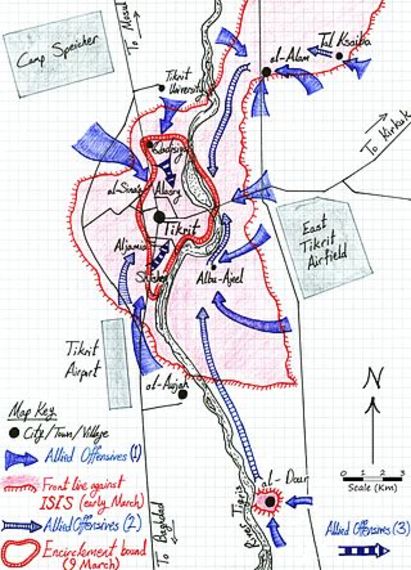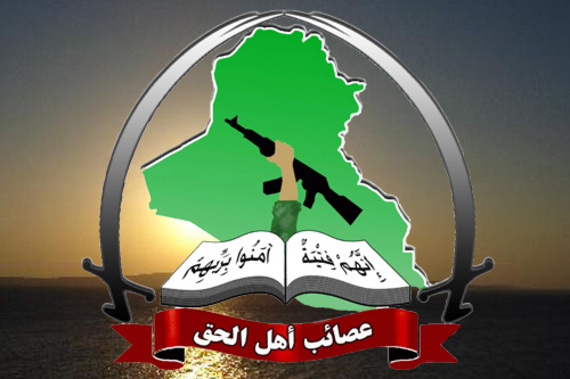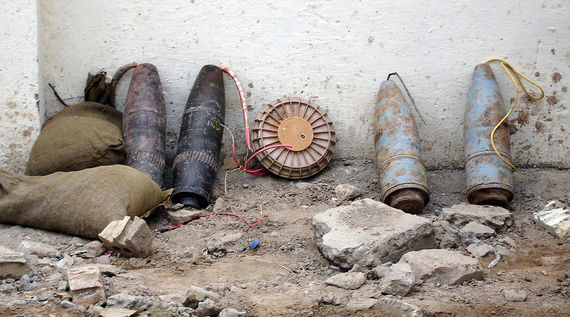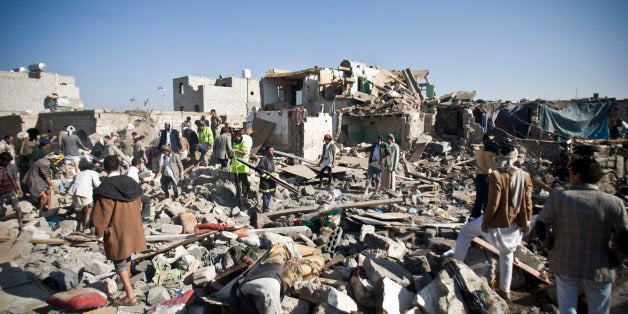
The cities of Aden and Tikrit are roughly 1,500 miles apart as the crow flies. Between them the two cities frame the Arabian Peninsula. This week both cities were subject to an intense air campaign. The genesis of those two operations, and the consequences that they precipitated, speak volumes of the current realignment that is reshaping the political dynamic of the Middle East.
The port city of Aden sits in the southwest corner of the Arabian Peninsula. It lies on the Indian Ocean, just kitty corner from the entrance to the Red Sea. It overlooks one of the busiest shipping lanes in the world; a route which is a key lifeline in the global petroleum trade. Historically, its geostrategic importance at the southern entrance to the Red Sea was second only to that of the Suez Canal. From the sixteenth century on, it was an important military outpost that controlled European access, via the Red Sea, to the Indian Ocean and the trade riches of Asia.
On March 25, Houthi forces from the Ansar Allah militia (Supporters of God), a Shiite, Iranian backed, militant group attacked the al-Anad air base approximately 30 miles north of the seaport of Aden. The attack on the base was part of a larger operation designed to consolidate the Houthi positon in Yemen by seizing control of the country's second largest city and economic center. Earlier in the year, following the takeover of Saan'a by Ansar Allah militants on January 20, 2015, the Houthis had dissolved the Yemeni government.
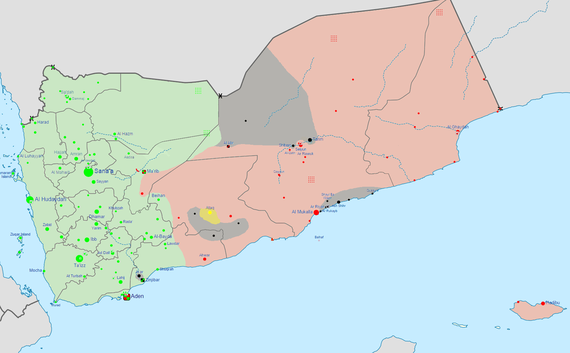
Green Areas are Houthi Controlled, Grey Areas are AQIAP Controlled and Pink Areas are Controlled by the Yemeni Government Although these Areas are Largely Desert
Yemeni president Abd Rabbuh Mansur Hadi had declared, on March 15, 2015, that Aden was the temporary capital of Yemen and urged government employees to relocate there. The city was the last stronghold of the Hadi government. Following the seizure of the al-Anar air base by the Houthis, Hadi fled the country and escaped to Saudi Arabia. Simultaneously, Hadi issued a request to the Arab league and to the U.N. Security Council to intervene in Yemen to restore his government. The next day, a Saudi led coalition began air attacks against Houthi targets in Yemen.
According to Saudi sources the coalition consisted of more than 10 nations, including the members of the Gulf Cooperation Council, with the exception of Oman, as well as Morocco, Jordan, Sudan, Egypt and Pakistan. Saudi Arabia confirmed that it had committed 100 Royal Saudi Air Force jets to the operation and that an additional 30 planes had been supplied by the United Arab Emirates, 15 each from Bahrain and Kuwait and 10 from Qatar. Additional planes had been supplied by Jordan, Morocco and Sudan. Pakistan and Egypt had, according to Riyadh, supplied naval forces.
As of March 27, however, Pakistani government officials claimed that the government in Karachi was still reviewing the extent of Pakistan's role in the operation. Significantly, Turkey quickly offered support for the Saudi led intervention and suggested that it might participate by offering logistical support. In addition, Saudi Arabia claimed it was prepared to commit up to 150,000 ground troops to the "Decisive Storm" operation.
Officially, the intervention by Saudi Arabia and its coalition partners was to "answer the call of President Hadi to protect Yemen and its people from the aggression of the Houthi militia." Hadi flew to Sharm el-Sheikh on Friday to address the Arab league meeting being held there over the weekend. The Saudi led intervention was expected to receive official Arab league approval.
It is hardly surprising that Riyadh would find the prospect of a Shiite militia led, Iranian backed, takeover of Yemen threatening. There are three particular elements of the Saudi intervention that are worth pointing out, however.
First, although the intervention was ostensibly in response to Hadi's request for assistance to the Arab league, military operations began before the Arab League had officially taken the matter under consideration. Moreover, only 11 of the Arab League's 22 members opted to participate. Pakistan is not a member of the Arab League, neither is Turkey. Significantly, none of the Arab states with Shiite dominated governments, opted to become involved. Even more notable, the operation came together will little input or participation of the United States.
The fact is this was a Saudi organized, "Sunni" intervention against an Iranian backed, Shiite overthrow of a Sunni government. From that standpoint it represented a significant escalation to the previous Sunni-inspired interventions during the Shiite led demonstrations in Bahrain and the other Gulf states during the 2011 Arab Spring unrest. It was also a clear signal that Shiite unrest that threatened the stability of the Sunni governments of the Arabian Peninsula would also be met with an armed intervention.
Secondly, noticeably quiet in the fight against the Houthi rebels was Al-Qaeda in the Arabian Peninsula (AQIAP). In the last several years, AQIAP has emerged as al-Qaeda's most operationally sophisticated and largest "franchise" among its international affiliates. The Hadi government was cooperating with the United States in America's ongoing was against al-Qaeda. An American contingent at the al-Anad air base was responsible for coordinating drone strikes against AQIAP militants.
In recent weeks, a Sunni militant group identifying itself as "Sana'a Province" and claiming to be an affiliate of Islamic State, took responsibility for four suicide bomb attacks against the Badr and al-Hashoosh mosques. A fifth attack against a mosque in the northern city of Saada was foiled.
AQIAP militants did capture the city of al-Houta, capital of Lahj province, about 20 miles to the east of Aden, on Friday March 27. They killed 20 soldiers before being driven out by Yemeni government forces loyal to President Hadi. Other than for this one incident, they have been relatively quiet.
The third notable development was the involvement of Pakistani military forces. The Pakistani military has long standing ties to the Gulf States. Many military personnel from Saudi Arabia and the GCC have trained in Pakistani military facilities. Former Pakistani military officers are conspicuous as trainers and advisers in the armed forces of the Gulf States. There is also a significant Pakistani civilian population, estimated at approximately one million, employed in the Gulf. A formal military participation for Pakistani armed forces in the region would represent the first "official" role for Pakistan since its participation in the First Gulf War over 25 years ago.
More importantly, there are deep and long-standing ties between the Saudi monarchy and Pakistani Prime Minister Nawaz Sharif. Moreover, Pakistani military forces have a long history of intervening in support of Saudi Arabia, dating back to at least 1969. During the 1970s and 1980s, approximately 15,000 Pakistani troops were stationed in Saudi Arabia.
There have been persistent rumors, including a report by the BBC in 2013, although no hard evidence, that Riyadh helped finance the Pakistani nuclear development program. There have also been reports that the Saudis have obtained Pakistani designed ballistic missiles capable of carrying atomic warheads. The Saudi monarchy has publically stated that it considers Pakistan to be its closest non-Arab ally and its closest Muslim ally. With one of the largest armies in the world and the only Muslim nuclear power, Pakistan plays an important role in securing the kingdom's defensive needs.
Pakistan's potential military role in the Gulf as a key element of a broad Sunni alliance is not without some risks. After Iran, Pakistan has the second largest community of Shia's, just slightly larger than Iraq's Shia population. There has been steadily mounting violence against Pakistan's Shias by a number of Sunni jihadist groups in Pakistan. To date, there has not been much evidence of Iranian involvement with Pakistan's Shia community. This could change very quickly however and Pakistan could easily find itself on the frontline of the broader Sunni-Shia rivalry.
In the meantime, on the other side of the Arabian Peninsula, U.S. and Coalition air forces attacked Islamic State militants in the city of Tikrit. The air attacks came at the "official request" of the Iraqi government and were in response to the failure of a ground force, made up primarily of Iranian backed Shia militias and elements of the Iranian Revolutionary Guard and Quds Force, to seize Tikrit. The original operation had been launched without the "official support" of the United States. Sources at the White House and the Pentagon had both confirmed that they had not been made aware of the impending operation before it started and that the U.S. had not provided air support.
Despite initial success against Islamic State militants in the area, the advance quickly bogged down, however. The Iraqi force was successful in surrounding Tikrit and cutting IS militants there from further reinforcements. As of March 28, approximately half of the city of Tikrit was in Iraqi hands and the balance was still controlled by Islamic State.
The United States insisted that the Shia militia groups pull back from the front lines around Tikrit as a precondition for coalition air strikes. The request was made in order to ensure that there would not be any need to coordinate the air attacks with forward units of the Shiite/Iranian force. In testimony to the Senate Armed Services Committee, General Lloyd Austin, head of the U.S. Central Command, stated that "I will not, and I hope we never, coordinate or cooperate with Shia militias." The pullback would also reduce the possibility of inadvertently striking any of the Shite militias in the areas during the air attacks.
In response to the launch of American air strikes, the Kataib Hizbollah (Hezbollah Battalions) and Asaib Ahl al-Haq (League of the Righteous) militias both suspended their further participation in the operation to take Tikrit in protest and withdrew their forces to a rear area. The two militia groups are comprised of Iraqi Shiites and claim to be loyal to Iranian Supreme leader Sayyid Ali Khamenei. They have received training, financing and arms from the Iranian Quds Force. Both organizations are listed as "terrorist groups" by the United States. They were implicated in thousands of attacks against U.S. forces in Iraq. The two groups comprised about 10,000 fighters, roughly one-third of the attacking force.
There is little doubt that the withdrawal of the two groups was on the instructions of Iran and that in doing so, Tehran was sending the Baghdad government a thinly veiled message that the Iraqi government would have to choose between relying on American air power or the "boots on the ground" that the Iranian Revolutionary Guard/Quds Force and their Shiite militia allies could supply.
It's also been suggested that the "controversy" surrounding the U.S. air strikes in Tikrit reflect operational differences in strategy between the Iraqi government, who is anxious for a quick advance, and a slower, more deliberate Iranian approach of surrounding Tikrit and slowly starving out the IS militants there. The "Iranian approach," it has been argued, would result in less damage to the city and fewer civilian casualties. This is not very plausible. The well documented record of atrocities and revenge killings by Shia militias against Islamic State militants and their suspected supporters makes it clear that, barring an escape, it will be a fight to the death for any remaining IS militants in Tikrit.
Moreover, the city has been extensively booby-trapped. A Wall Street Journal report by Matt Bradley on March 19 claimed that the city center of Tikrit alone had been mined with more than 6,500 improvised explosive devices (IEDs). Moreover there have been reports that IS has built an extensive network of tunnels in Tikrit allowing it to move its troops out of sight of Iraqi forces as well as allowing it to strike in the rear of the Iraqi lines.
The battle for Tikrit is a very good indication of the difficulty that Iraqi forces will encounter in trying to roll back the Islamic State. Iraqi forces can make quick progress in retaking outlying areas. These areas have relatively easy terrain, lack any kind of defense in depth and will prove particularly susceptible to air power. Moreover their overwhelming advantage in manpower, a key element of Iranian "swarm tactics", will allow them to surround their target and cut it off from further reinforcement since under the circumstances it's unlikely that Islamic State militants will favor a pitched battle against Iraqi forces.
Once the outlying districts have been captured, however, and the target city surrounded, progress is likely to slow down considerably. Iraqi forces can expect to find Islamic State militants deeply entrenched in an urban nightmare of bobby traps and IEDs. Further advance will require a street by street, building by building, campaign of urban warfare against an opponent determined to fight to the death. Under these circumstances urban damage will be extensive and civilian casualties, assuming there are any civilians left, will be considerable. This was precisely the reason why the U.S, after its experience in the Battle of Fallujah, avoided urban battles with jihadist militants during the Iraqi Civil War.
Moreover, the deep distrust with which the Shiite militias view American forces in Iraq and Tehran's desire to minimize and isolate American influence in Baghdad will further complicate the military campaign. Many of these militias fought against U.S. forces while they were stationed in Iraq. Moreover, Iraqi media frequently air reports that the United States is secretly arming and financing Islamic State militants while surreptitiously attacking pro-government fighters. What is particularly troubling is that such sentiments can be found at the highest levels of the Iraqi government and military. A Washington Post report by Loveday Morris on March 27 quoted Iraqi Brigadier General Abed al-Maliki's claim that "everybody knows that the Americans are dropping supplies to Daesh."
The Baghdad government is finding itself in a positon where its most effective military force is controlled by Tehran, while at the same time the "regular" Iraqi military, after a disastrous showing against Islamic State, is being rebuilt under American supervision. Ultimately, it will have to find a way to either reconcile the two forces or dismantle the Iranian/Shiite militia proxy army. Neither task will be easy and neither task offers much hope for the future stability of the Iraqi government.
Two cities, two air campaigns. In many ways completely different from each other, and yet both underscore the growing power and influence of Iran in the Middle East. From Riyadh's perspective, these two conflicts at opposite ends of the Arabian Peninsula are just the opening round in the looming battle for Arabia.

